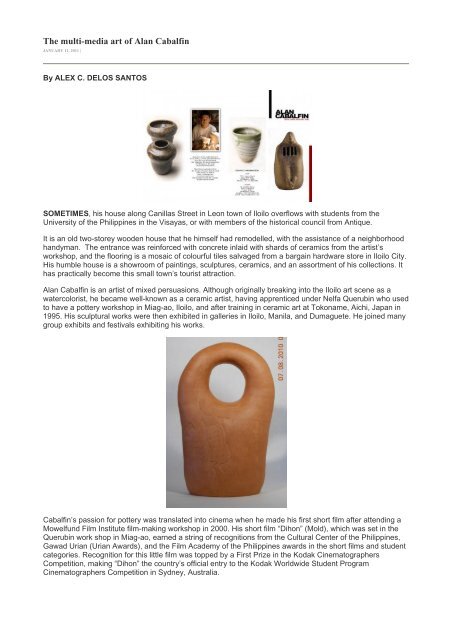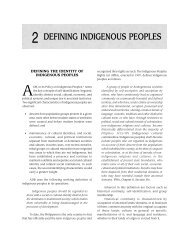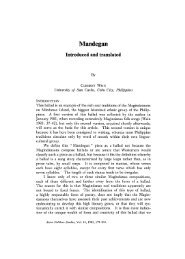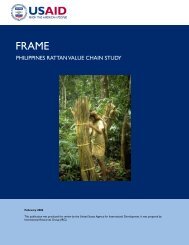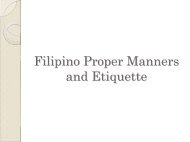The multi-media art of Alan Cabalfin - Philippine Culture
The multi-media art of Alan Cabalfin - Philippine Culture
The multi-media art of Alan Cabalfin - Philippine Culture
Create successful ePaper yourself
Turn your PDF publications into a flip-book with our unique Google optimized e-Paper software.
<strong>The</strong> <strong>multi</strong>-<strong>media</strong> <strong>art</strong> <strong>of</strong> <strong>Alan</strong> <strong>Cabalfin</strong><br />
JANUARY 11, 2011 |<br />
By ALEX C. DELOS SANTOS<br />
SOMETIMES, his house along Canillas Street in Leon town <strong>of</strong> Iloilo overflows with students from the<br />
University <strong>of</strong> the <strong>Philippine</strong>s in the Visayas, or with members <strong>of</strong> the historical council from Antique.<br />
It is an old two-storey wooden house that he himself had remodelled, with the assistance <strong>of</strong> a neighborhood<br />
handyman. <strong>The</strong> entrance was reinforced with concrete inlaid with shards <strong>of</strong> ceramics from the <strong>art</strong>ist’s<br />
workshop, and the flooring is a mosaic <strong>of</strong> colourful tiles salvaged from a bargain hardware store in Iloilo City.<br />
His humble house is a showroom <strong>of</strong> paintings, sculptures, ceramics, and an assortment <strong>of</strong> his collections. It<br />
has practically become this small town’s tourist attraction.<br />
<strong>Alan</strong> <strong>Cabalfin</strong> is an <strong>art</strong>ist <strong>of</strong> mixed persuasions. Although originally breaking into the Iloilo <strong>art</strong> scene as a<br />
watercolorist, he became well-known as a ceramic <strong>art</strong>ist, having apprenticed under Nelfa Querubin who used<br />
to have a pottery workshop in Miag-ao, Iloilo, and after training in ceramic <strong>art</strong> at Tokoname, Aichi, Japan in<br />
1995. His sculptural works were then exhibited in galleries in Iloilo, Manila, and Dumaguete. He joined many<br />
group exhibits and festivals exhibiting his works.<br />
<strong>Cabalfin</strong>’s passion for pottery was translated into cinema when he made his first short film after attending a<br />
Mowelfund Film Institute film-making workshop in 2000. His short film “Dihon” (Mold), which was set in the<br />
Querubin work shop in Miag-ao, earned a string <strong>of</strong> recognitions from the Cultural Center <strong>of</strong> the <strong>Philippine</strong>s,<br />
Gawad Urian (Urian Awards), and the Film Academy <strong>of</strong> the <strong>Philippine</strong>s awards in the short films and student<br />
categories. Recognition for this little film was topped by a First Prize in the Kodak Cinematographers<br />
Competition, making “Dihon” the country’s <strong>of</strong>ficial entry to the Kodak Worldwide Student Program<br />
Cinematographers Competition in Sydney, Australia.
His love affair with film led him to work with several film projects: as production designer in Nick Deocampo’s<br />
“Mother Ignacia,” and as <strong>art</strong> director in Jonar Pueblo’s Ilonggo film “Dagyang.” He also directed the<br />
“Samayaay” video for the Iloilo National High School Special Program for the Arts.<br />
But <strong>Cabalfin</strong>’s <strong>multi</strong>ple talents was not left unnoticed by those he was able to work with. Soon, he found<br />
himself designing galleries for exhibitions and museums and doing sets for stage productions. He was asked<br />
to design the RVM Historical Museum and later the Heritage Hall in Quezon City, the Lourdes College<br />
Museum in Cagayan de Oro, the Evelio B. Javier Gallery and the Museo Antiqueño in San Jose, Antique,<br />
and the Guimaras Provincial Museum and Monument in Jordan, Guimaras. His practical yet highly creative<br />
and versatile stage designs using textiles were well appreciated by directors who asked him to design sets<br />
for ballet, sarswela, and even beauty pageants!<br />
As <strong>art</strong> director for Miss Dinagyang and Lin-ay kang Antique for several years, <strong>Cabalfin</strong>’s touch was seen in<br />
drapes and painted sceneries that complement the various segments <strong>of</strong> the pageant, much like imitating the<br />
patadyong (locally women textile from Panay). <strong>Cabalfin</strong> is well aware <strong>of</strong> the distinct weaving traditions in both<br />
Antique and Iloilo, that his production designs may well be a homage to these well-kept traditions.<br />
As an <strong>art</strong>ist, <strong>Cabalfin</strong> sees all these works not as mere money-making ventures. He believes that something<br />
must go back to the community where <strong>art</strong> belongs. While working as <strong>art</strong> director for the Museo Antiqueño in<br />
April 2007, where he did some terracotta dioramas, he was able to interact with the potters <strong>of</strong> Sibalom,<br />
where he sourced his clay. Seeing the traditional pottery-making in Bari, he volunteered to conduct<br />
workshops and lectures which helped the potters produce other designs aside from the functional banga<br />
(water jar), kuron (round bottomed-pot), and sig-ang (stove). Now, the potters dish out animal figurines,<br />
candle and lamp holders, which are easily picked up by garden enthusiasts at local trade shows. Six months<br />
later, he came back to the Museo Antiqueño for his the exhibition “Bag-o nga Daan,” his first pottery exhibit<br />
since his last in 1996.<br />
When <strong>Cabalfin</strong> was invited to exhibit at the <strong>Philippine</strong> Center in New York last year, he decided to bring to<br />
the Big Apple something <strong>of</strong> Panay. His solo exhibition that ran from July 12-23, 2010 at the lobby <strong>of</strong> the<br />
<strong>Philippine</strong> Center was titled “Binanog: Panay Bukidnon on the Rise.” Binanog is the dance <strong>of</strong> the Panay<br />
Bukidnon, imitating the movements <strong>of</strong> the banog bird. <strong>The</strong> exhibition featured his paintings and ceramics that<br />
capture the delicate motifs <strong>of</strong> the Panay Bukidnon embroidery called panubok and the energetic movements<br />
<strong>of</strong> the binanog dance. One p<strong>art</strong>icular painting is a triptych called “Binanog sa Siyudad,” (Binanog in the City)<br />
showing three binanog dancers, each against the backdrop <strong>of</strong> urban skyline, identifiably Iloilo City,<br />
Hongkong, and New York.<br />
Coming home from that New York exhibition, <strong>Cabalfin</strong>, hastily prepared another painting exhibit called<br />
“Binanog sa Siyudad” for the Karay-a Arts Festival held at Gaisano Grand Mall <strong>of</strong> Antique on October 22-23.<br />
He was so filled with inspiration. “I think that in my next projects, I will consciously try to show not only my <strong>art</strong>,<br />
but my culture as well,” he said.<br />
Look also www.Sculptors.<strong>Philippine</strong><strong>Culture</strong>.ph


